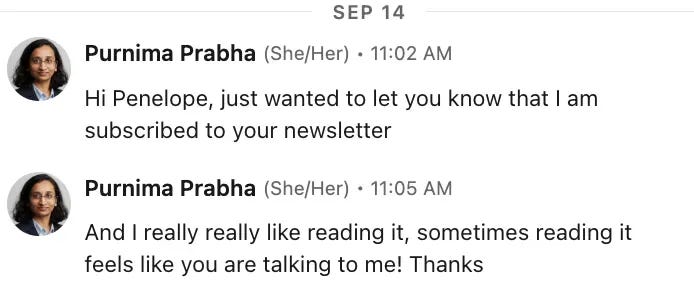Day 7 - 2 Apps I Use During Deep Work to Boost My Focus As A Data Scientist
(Read this if you sit down to work but end up checking your phone every 10 minutes)
Welcome back to Day 7 of The 30-Day Career Accelerator for Data Scientists!
For the longest time, I couldn’t sit through a deep work session without getting pulled away.
I would block off two hours to debug a model or finish an analysis.
Notebook open. Queries ready. Coffee on my desk.
And yet… 10 minutes in, I was:
Checking Slack “just in case.”
Refreshing Outlook.
Scrolling LinkedIn because it felt easier than wrestling with Python errors.
By the time I got back to my code, the focus was gone and I had to jump to my next meetings…
That’s the hidden cost of distraction nobody talks about.
That was my reality until about 6 months ago. Since then, I’ve been using two apps that have completely changed the game for my focus.
And that’s where these two apps changed the game for me.
The Hidden Brain Science of Focus: Dopamine, Distractions, and Flow
Why Staying Focused Feels Impossible
Here’s what’s really happening when you reach for your phone mid-analysis.
Every time you check Slack, refresh Gmail, or scroll LinkedIn, your brain gets a tiny hit of dopamine aka the “reward” neurotransmitter. Over time, your brain starts craving these micro-rewards, even when they derail your work.
Psychologists call this the dopamine reward loop.
The more you indulge it, the harder it becomes to stay with tasks that require sustained effort (like debugging or building models).
And the data backs this up:
Researchers at UC Irvine found that once you’re distracted, it takes an average of 23 minutes to fully refocus on the original task (Mark et al., 2008).
Another study from the University of Texas showed that even the presence of a smartphone nearby reduces working memory and fluid intelligence — your brainpower is split, even if you don’t touch it (Ward et al., 2017).
So if you feel like focus is harder than ever, it’s not because you’re “lazy.”
It’s because your brain is literally being trained to seek the quick dopamine hit instead of the long-term reward of deep work.
That’s why I stopped relying on willpower alone — and started using tools that re-engineer my environment for focus.
What Happens Once You Finally Get Focused
Once you break through the distraction cycle and settle into deep work, your brain chemistry flips.
Here’s what the science shows:
You start producing dopamine in response to progress on the task itself (not external distractions). That makes the work intrinsically rewarding, so you actually want to keep going.
Brain scans show higher levels of norepinephrine and acetylcholine during states of flow, both of which heighten attention and improve learning (Ulrich et al., 2014).
Over time, consistent deep work builds stronger neural pathways associated with focus — essentially training your brain like a muscle (Newport, Deep Work; also supported by research on neuroplasticity).
This is why deep work feels so energizing when you’re in it:
Your brain is no longer chasing tiny dopamine spikes, but instead riding a steady stream of reward chemistry tied to meaningful progress.
That’s the state I try to engineer every day now — and the two apps I’ll share below make getting there much easier.
2 Apps I Swear By for Deep Work
These two apps have been game-changers for me.
One keeps distractions from ever hijacking my focus. The other uses brainwave stimulation to guide my mind into that calm, locked-in state where deep work happens naturally.
Together, they’ve made it easier to protect my attention and get into flow on demand.
1. OneSec (blocks distractions before they start)
OneSec literally stops me from opening apps like Instagram, LinkedIn, or Gmail on autopilot.
The moment I tap one of those apps, OneSec hijacks the process. It makes me take a deep breath, wait, and decide: “Do I really want to open this right now?”
Most of the time, that’s enough for me to back out before the doomscroll even starts.
Instead of burning 15 minutes without noticing, I’m back to my notebook in seconds and the focus stays where it belongs.
And because I never actually reach the app, I don’t get the little dopamine hit my brain is expecting.
No reward → less craving → less chance I’ll try again five minutes later.
Over time, this has rewired my default behavior. Instead of doomscrolling on autopilot, I stay locked into my analysis or coding session.
2. Brain.fm (music designed for focus)
Spotify focused-work playlists are fine. But Brain.fm is on another level.
The app uses AI-generated soundscapes backed by neuroscience research. Their music is engineered to sync with brainwave patterns that improve focus, creativity, and flow.
Within 10 minutes, I feel like my brain is in “tunnel vision mode” but without the stress.
It’s my secret weapon for getting into the zone fast, especially on coding or analysis tasks.
Quick Ask: Share this with a friend
I want to help more data scientists build careers where promotions aren’t a mystery.
If you know a friend or colleague who’s working hard but feels stuck, forward them this email.
It might be the nudge they need to start building the habits that lead to their next promotion.
Look at what this subscriber is saying: 🙂
Coming Up Tomorrow 👀
We’ll talk about the hidden danger behind using ChatGPT as a data scientist, and how to use it in a smart way… This one hurts ahah
Until Next Time,





